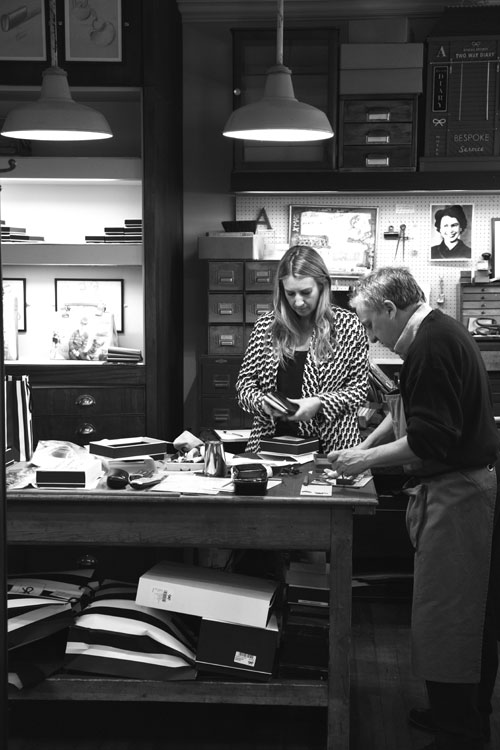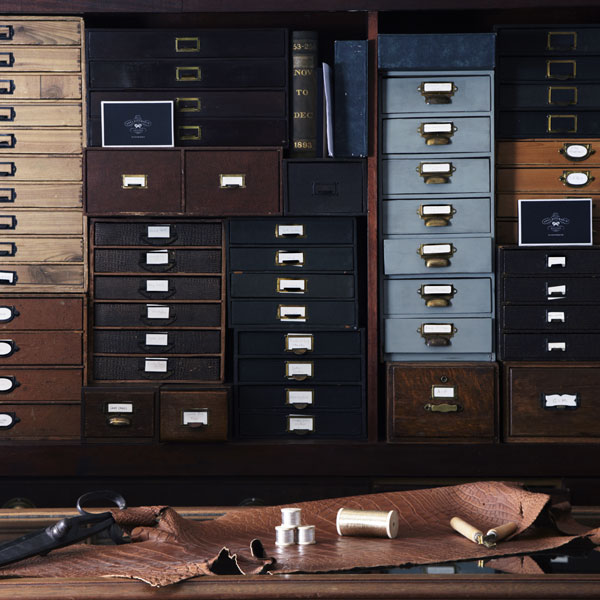Previous Article
Next Article
- AM WORLD
- 100 YEARS OF ASTON MARTIN
Lifestyle

Portraits by Phillip Sinden
For acclaimed designer Anya Hindmarch, a handbag says so much about taste and design. Contributing editor Stephen Bayley discovers her definition of luxury and what the future holds for high-end fashion accessories.
“The great thing about a handbag” is, perhaps, a curious, even outrageous, certainly downbeat, and let me immediately say slightly misleading, beginning to a story in a magazine devoted to the culture of voluptuous cars with an average output of more than 450 horsepower. But great handbags and great cars have more in common than leather and metal. They are significant weapons in the battle for personal identity.
One of the great things about a handbag is, if you know what to look for, that scrutiny of it reveals things about style and personal taste while being an accurate, if mischievous, indicator of net worth. And this is without even thinking about the, often, incriminating contents, that bag-full of guilty scraps and dodgy pharmaceuticals that psychotherapists sometimes suggest might beneficially be emptied on the floor and discussed by the group.
It’s not a matter of consumer psychology, but design, although the two things are closely related. I am often asked about design and, to avoid the embarrassment and pain of having to think for myself, usually quote Ben Jonson: “In small proportions we just beauties see/And in short measures life may perfect be.” It’s a matter of details.
I mean: you need to pay attention to everything, starting with the small stuff. Properly understood, having dealt with design, a handbag can also tell stories about the principles of manufacturing philosophy, political economy and product semantics. This is not a woman-only conversation. These truths are as relevant to looking at handbags as to owning them. Anyway, “the great thing about a handbag” according to Anya Hindmarch, one who knows, eyeballing me in a most fetching manner, “is that you don’t have to try it on. There’s none of that struggling in changing rooms or that undignified posing in front of mirrors. Yet it’s something completely character-changing and mood-enhancing.”
Changing character and enhancing moods? Isn’t this why we acquire any goods beyond mere essentials? Isn’t this what luxury means, a catalyst of the ordinary? A little piece of leather that’s well put together is not just a matter of yeah-yeah, it is the whole world in miniature. At this point I am addressing male readers: you don’t own a handbag? Maybe you should. Hindmarch has made her almost mystical fascination with handbags into a business with a lustrous global presence, from Aoyama to the other end of the alphabet.
Thirty people were injured in a hysterical 2007 scrum getting into her new Taiwanese store. But I am not here to discuss particular business dynamics, nor mass frenzy amongst Taipei shoppers, rather, to get a sense of how one of Britain’s most successful woman designer-maker-entrepreneurs defines modern luxury and its metaphors. We have met before and I know she agrees that, like everything else, from the colour of polar bears to the size and composition of pizzas, definitions of luxury are changing fast.
We are in Belgravia, in central London, where the laboratory that is the Anya Hindmarch Bespoke shop, amusingly opposite Agent Provocateur, is located. Louboutin is half a block away. I am 10 minutes in advance because it is bad manners to be late, but also inelegant to be early, so I walk up and down Pont Street taking in the scene, a vista that soothes the mind and eye with the gentle airs and graces of great wealth. Appropriate to the setting, Hindmarch’s Bespoke premises are an elegant, brick-built Georgian low-rise with sashes above glowing vitrines framed by coruscating black window-furniture decorated with gold sign-writing. It suggests confidence and offers a delicious promise of that sense of well-being acquired, if all goes well, by the consumption of exclusive merchandise.
I walk in two minutes before the 5.30pm appointment. A beaming assistant strides boldly forth and, before I can finish “I have come to see...”, Hindmarch appears in my peripheral vision. She is sitting in the corner at a simple table with a mug of tea. Outfit? Cardigan and jeans, stand-out simplicity for over-wrought Belgravia where maids shopping in Waitrose wear Armani. She rolls her eyes and says: “I thought it was meant to be five.” No sense of recrimination detected or intended, more a suggestion of life’s continuous ability to upstage even the human race’s most ambitious and best-organised members.

At work in the studio to the rear of her London boutique store, where bespoke goods are manufactured for her worldwide clientele
“Show me your bag. It’s marvellous.” This is what Hindmarch, confirming the thesis of this article without delay, immediately says to me. It’s my habit to travel everywhere, even 20 minutes from home or office, with a very baggy brown suede grip made by Nivaldo de Lima, an ursine Brazilian artisan with one foot in Mallorca and another in London. He is a man who can discuss at meaningful length the true nature of a leather tassel. Such things matter.
My Nivaldo bag is a sort of mobile autobiography: scarred by travel, battered by accident with stains of forgotten provenance and rammed with notebooks, wallet, passport, pens, keys, cameras, phone, books and newspapers. Touching it in a way David Attenborough might a rare species on the verge of extinction, Hindmarch says: “I learnt from my parents that luggage can say so much about someone. It’s the smell, the memories. It’s a living thing.”
How true: you have those incurious and undemanding people content to contain their worldly goods in durable, but characterless and depressing pvc, or those who prefer expressive, but delicate, aluminium or, in Hindmarch’s case, evocative leather. Her parents, since details matter, favoured Tanner Krolle, once grand makers of classic leather travel wares. In her work, Hindmarch holds on to the essence of tradition, but is not enslaved by it. Conventions are enhanced by imagination, wit and irreverence. Looking at her mug of tea, she tells me: “I knew at 18 I wanted to work with leather.” Italy was crucial. First, a hand-me-down Gucci bag became an object of veneration to the 16-year-old. Three years later, a trip to Florence brought first-hand experience. “Florence,” she said, “is quite literally the home of the handbag. I became excited by the business of leather and how everything works.”
And in this practical note was an elegiac touch. This was the early Eighties and London’s old leather business was dead, but Florence’s tanneries in Santa Croce sull’Arno were still active. Even today, while Hackney and Bermondsey just retain melancholic memories of the leather trades in street names, there are merchants in Florence who will sell you a second-hand Settorella setting-out machine for £27,000. This typically Italian mingling of commerce and culture, where machine-tools are sold in the home of the renaissance, of life and art being co-mingled, became a continuing inspiration. With borrowed money, Hindmarch imported 500 drawstring leather duffel bags she found in Florence and was very promptly in business back home.
Understanding how design is inextricable from manufacturing remains a preoccupation: Hindmarch is a confidante of Prime Minister David Cameron and a roving trade ambassador. We had another warming huddle of agreement about the idea of making things being necessary to both culture and the economy. But I also wanted to know if Hindmarch, who six years ago made a global fad with her environmentally right-on anti-plastic bag, had a concept of luxury when she was a child. And the answer was yes. Cars were influential. She was brought up with the smell of her father’s cigars and the linked sensation of riding in his Jaguar E-Type, two memories suggesting how romantic memory and memorable form, not to mention speed and thrust, have played their part in her personal aesthetic.
“The funny thing about being in a nice car is that the experience is artisanal, not production-line slick.” At this point Hindmarch starts an eloquent digression on the form and function of the E-Type’s gear-lever, how the slender chrome shaft is topped by a delicately ovoid, but deliciously tangible, ovoid blob. “It’s a composition in every way satisfying.” These same qualities of tactility and elegance she seeks now in her own work. Must exclusive merchandise be hand-made? Can you have mass-produced luxury? “Hmmm. I’m not sure,” she demurs.
To Hindmarch, one of the other great things about a handbag is that it is not necessary. This freedom from the surly bonds of grim functionality—at least, functionality in the way it might be understood by Social Services—gives both creative freedom to the designer-maker and a generous measure of pleasure to the eventual user. When I mention Bernard Berenson’s belief that “taste begins when appetite is satisfied”, she reaches eagerly for a pen (although I note with satisfaction she cannot actually find one in her bag). Thing is, with a limited range of leather, fabric and metal, an ingenious handbag designer can create a world of values, an environment of style and a micro-climate of desire. The modern handbag is a creative discipline as much as it is a practical container.

All very well, I now say, but, c’mon, several thousands for a bag when there are beggarwomen and shoeless waifs on the streets of Glasgow? The high-concept handbag is surely an affront to humanitarian ideals in our strangulated economy? Hindmarch has been asked this before. “Whatever anybody spends their money on is fine. Each to their own. If you lose aspiration, you have lost the will to live. Personally, I would rather do without than have rubbish.” I admire this Ruskinian conviction which suggests that to value things on cost alone is a poor way to decide merit.
So there are, besides scrumpled Kleenex and eyeliner, some principles to be found inside handbags, which illuminate the larger idea of design. One is adaptability. Something well-designed should work well in different circumstances: Hindmarch’s hand-me-down Gucci bag was carried to flatter a tracksuit and subtly complement a little black dress. And to design a successful handbag, ideas and passion are not enough. You need to understand materials and industrial processes as well. Naturally, special insights into the soul of the consumer are also required.
Introducing the idea of luxury takes us a little further. Hindmarch agrees that luxury today is not about opulence and excess, but intelligence and taste. As Coco Chanel said, luxury is not the opposite of poverty... it is the opposite of vulgarity. Still, elements of exclusivity and strong narrative content are inalienable from authentic luxury. Products must tell stories. Here Hindmarch cites a much-loved and far-travelled trunk made for her husband’s grandfather, a vessel of unusual size to accommodate unusual shoes for unusually sized feet. Hindmarch talks with passion about a highly personalised wallet she has just made for her son. She adores a 400-year-old scent-maker discovered in Tangiers, the decadent Moroccan port that is a favourite destination. But it is an important Hindmarch principle that the thrill of exclusiveness essential to a luxury experience need not be expensive: idiosyncrasy is just as valuable. She says with correct pride: “A specialist lightbulb shop is a luxury to me.” And is her idea of luxury food a terrine of Girondais larks’ tongues in antique champagne jelly? No: “Soup is the food of the gods.”
Hindmarch told The New York Times in 1992, at the very beginning of her career: “I start with a very bad sketch.” She actually started with a very good idea. This was to do the ordinary thing extraordinarily well. And then the extraordinary thing done even better. Luxury is an attitude as much as it is a specification of fine materials and a schedule of lofty prices. It’s about ideas and experiences as much as weights and measures. And it lasts.
I often think the true test of desire is if you are willing to steal something. Are you still keeping your BA First Class amenity bag? I know I am. Anya Hindmarch created it. Now I want to start writing “The great thing about an amenity bag is...” One of the great things about the new luxury is not that it swaddles you with suffocating comfort, but that it makes you think.
Previous Article
Next Article
- AM WORLD
- 100 YEARS OF ASTON MARTIN



